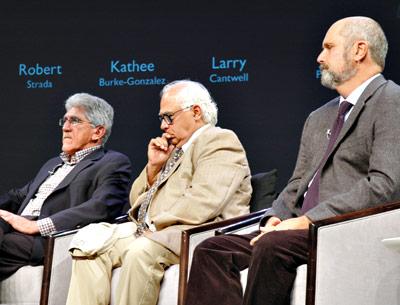Town Pols Pressed on Preservation

Faced with the decidedly loaded question, “Preservation: Have We Gone Too Far?” at a forum last Thursday sponsored by LTV and the East Hampton Historical Society, the candidates for East Hampton Town Board agreed that more needed to be done to protect the town from overdevelopment.
The hourlong discussion followed the screening of “East Hampton in the 1920s and 1930s,” footage of local scenes from those decades filmed by Hamilton King, a successful commercial artist turned landscape painter, and a short preview of “A Sense of Place,” a collection of oral history interviews with the town’s senior citizens.
After the audience watched Mr. King’s grainy black-and-white images of Town Pond and Home, Sweet Home, whaleboats entering the surf, bathing beauties at Main Beach, a tennis match at the Maidstone Club, the Ladies Village Improvement Society Fair, and a seemingly endless procession of 1920s fire trucks rushing to a fire, Robert Strada, LTV’s chairman, led the candidates in a panel discussion.
“Everyone was taken with the phrase,” Mr. Strada said, referring to the forum’s title. “Does ‘have we gone too far?’ mean there is too much preservation or the town has changed so much that it’s too late?”
It is certainly not too late, said Kathee Burke-Gonzalez, a Democratic and Working Families candidate. An advertising account executive, she said she thought the title “was a little cheeky to elicit interest and entice people to show up.” A native of Valley Stream, she said her former community has been reduced to “strip malls and car dealerships and gas stations. Kudos to East Hampton.”
“We have a moral obligation to do a lot more,” offered Larry Cantwell, the Democratic, Working Families, and Independence candidate, who is running unopposed for supervisor.
Both Councilman Dominick Stanzione, who is seeking a second term on the Republican, Independence, and Conservative lines, and former Councilman Job Potter, who is backed by the Democrats and Working Families parties, agreed. Town Clerk Fred Overton, who is running with Mr. Stanzione, could not attend the event because he was out of town at his daughter’s wedding in Massachusetts, but in a statement read by Bob Schaeffer, he too offered support for continued efforts using the town’s preservation fund.
With the general consensus that East Hampton Village had been more successful than the town in its preservation efforts, Mr. Cantwell said the village had involved residents in the process. When the village created historic districts, for instance, “we started out by meeting with the people who lived in those neighborhoods,” he said. “Instead of proposing a law, we had coffee.”
“Everyone on the streets accepts some limitations,” he added, referring to architectural review. “Everyone accepts that and everyone’s neighbor accepts that, so everyone is together.”
The village recently adopted a new law that allows residents who own historic timber frame houses the right to build a guesthouse on their property in exchange for preserving the original building. Mr. Cantwell said the approach worked well when targeted properties were scattered about a wide area and not concentrated in a single neighborhood, and he added that he thought it could work in the town as well, an idea echoed by Mr. Potter, who suggested it could be used to preserve more modest houses in Springs owned by East Hampton Town’s farming and fishing families.
Asked why there were only two national landmarks — the Montauk Lighthouse and the Pollock-Krasner House in Springs — Mr. Stanzione said he would nominate the Amagansett Life-Saving Station as an ideal candidate, citing its role in the invasion by Nazi saboteurs in 1942 as well as the effort “to bring the community together to develop a new form of financing, which was really a public-private partnership.”
The next landmark could very well be the Thomas Moran house, the East Hampton Village house and studio of the landscape painter, said Mr. Cantwell, who nonetheless said the best protection for historic structures would be found in strict local laws.
Responding to a question about the size and mass of new houses being shoehorned into neighborhoods, Mr. Potter lamented situations in which “you have two 2,000-square-foot houses on half-acre lots and you put a 6,000-square-foot house between them.” The end result, he said, is “you’ve destroyed the neighborhood.”
Although she said she would support using preservation fund money to buy easements on existing historic houses, Ms. Burke-Gonzalez balked at a suggestion that the town might be able to provide financial aid for the maintenance of private historic houses that are opened to the public. “That’s tricky,” she said.
“In terms of the maintenance, I’m not seeing that happening,” agreed Mr. Cantwell. “Those are private homes; they should be maintained privately.”
What the town should do when the preservation fund expires in 2030 was also a topic of discussion. Ms. Burke-Gonzalez said since two prior referendums, one establishing the tax and the other extending its life, had been passed by majorities of more than 80 percent of the voters, she was confident it would be extended again.
Mr. Stanzione said he would like to see acquired land made more accessible to the public and better master plans in place. The town would likely earmark several million dollars for maintenance of public properties, he added. Plus, he said, “We might not have any more land to purchase.”
Mr. Cantwell said the town should focus on protecting groundwater, wetlands, the coastline, and farmland while focusing on smaller parcels that might help to improve the value of neighboring property.
Citing a pressing need for affordable housing, Mr. Potter said the preservation fund might be amended for that purpose. “I’m not sure that all that 2 percent 15 years down the road should go to land preservation,” he said.
